At first I was just going to write about My Dog Thinks I’m a Genius. It’s a brilliant book (with a great title), and certainly worth a stand-alone review. But then I started thinking about other books in my collection where painting is the focus, and four came to mind, although I’m sure there are many more that have escaped my memory (or awareness.) By definition, a picture book about painting double-serves the subject in that it is a work of art about the creation of art, assuming, of course, the illustrations are actually works of art, which is not always the case. However, with these five books (and the other titles listed at the end of this post), the exquisiteness of the art is indisputable, as is the quality (and sheer number) of apes, dogs, squirrels, and lizards populating the text. But then, what is a kids book, even a kids book about art, without a dog, or a lizard?
 In the aforementioned, My Dog Thinks I’m a Genius (Ziefert/Barroux, Blue Apple Books 2011) Harriet Ziefert tells the story of an eight year old boy and his dog, Louie. The boy loves to paint, and Louie loves to watch~and critique. As the story opens, the boy is working on a picture of a tall building, methodically adding each element until he believes the painting is done, but Louie’s barks suggest otherwise. Something is missing. The boy adds Louie to the painting and voilà, it is finished. (Hard to argue with Louie’s logic. Most things are improved with the addition of a dog.) However, as it turns out, Louie isn’t just a connoisseur of art, he may also be a budding canine Cézanne. Now who’s the genius?
In the aforementioned, My Dog Thinks I’m a Genius (Ziefert/Barroux, Blue Apple Books 2011) Harriet Ziefert tells the story of an eight year old boy and his dog, Louie. The boy loves to paint, and Louie loves to watch~and critique. As the story opens, the boy is working on a picture of a tall building, methodically adding each element until he believes the painting is done, but Louie’s barks suggest otherwise. Something is missing. The boy adds Louie to the painting and voilà, it is finished. (Hard to argue with Louie’s logic. Most things are improved with the addition of a dog.) However, as it turns out, Louie isn’t just a connoisseur of art, he may also be a budding canine Cézanne. Now who’s the genius?
My Dog Thinks I’m a Genius is absolute stunner. The illustrations by French artist Barroux are a mixed palette  of watercolour and pencil, scrawled, splashed, and (when it comes to the characters) meticulously drawn over thick, sometimes lined pages. The boy states, “I must draw and paint everyday”, and Barroux’s exuberant illustrations express the character’s love of painting in bright candy colours, shifting perspectives, and a very inventive use of space. Not unlike Cézanne, in other words, who is given a wonderful homage at the conclusion of the book. My Dog Thinks I’m a Genius celebrates the creative process as a messy, and often collaborative effort. It also slyly hints at the reality that there is always someone better than you, even if it’s your dog, but in the end the only thing that matters is that you love what you do. Suggested sequel: My Cat Thinks I’m an Idiot.
of watercolour and pencil, scrawled, splashed, and (when it comes to the characters) meticulously drawn over thick, sometimes lined pages. The boy states, “I must draw and paint everyday”, and Barroux’s exuberant illustrations express the character’s love of painting in bright candy colours, shifting perspectives, and a very inventive use of space. Not unlike Cézanne, in other words, who is given a wonderful homage at the conclusion of the book. My Dog Thinks I’m a Genius celebrates the creative process as a messy, and often collaborative effort. It also slyly hints at the reality that there is always someone better than you, even if it’s your dog, but in the end the only thing that matters is that you love what you do. Suggested sequel: My Cat Thinks I’m an Idiot.
According to three-time Caldecott winner David Wiesner, Art & Max (Clarion Books, 2010) was born out of the creative process itself, and in particular, the inherent possibilities of various mediums. If a character’s top coat of paint is ‘cracked’ to reveal a pastel drawing below, and then in succession, all of the layers are exposed, what remains of the original line drawing? What if it collapses into a single line? Can the character be restored? In yet another display of Wiesnerian logic, he dumps the early drafts of ‘cuddly creatures’ in favour of the stylistically more interesting lizard to answer these, and other, self-imposed questions. I mean, why not?
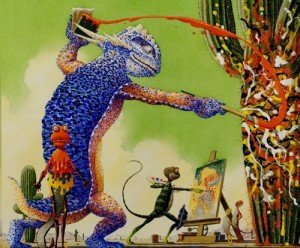 The big lizard is named Arthur (or Art, for short), a seasoned painter, and Max-a young iguana-like fellow with the curiosity and energy level of a five year old (on candy.) Art gives Max a canvas, but he has no idea what to paint. The older lizard says, “Well, you could paint me”, and that’s exactly what the iguana does: he paints Art, with every hue and colour in his paintbox. The formerly dun-coloured lizard has been transformed into a Pollockesque masterpiece, and he is not amused. Art shakes like a dog, and the paint (and all of his scales) explode off the page. What’s left is a softer, pastel-coloured lizard.
The big lizard is named Arthur (or Art, for short), a seasoned painter, and Max-a young iguana-like fellow with the curiosity and energy level of a five year old (on candy.) Art gives Max a canvas, but he has no idea what to paint. The older lizard says, “Well, you could paint me”, and that’s exactly what the iguana does: he paints Art, with every hue and colour in his paintbox. The formerly dun-coloured lizard has been transformed into a Pollockesque masterpiece, and he is not amused. Art shakes like a dog, and the paint (and all of his scales) explode off the page. What’s left is a softer, pastel-coloured lizard.
“Oh Max…what have you done?”
Max attempts to rectify the situation by hauling out a fan, which blows off most of the colour. A much needed glass of water downed by the parched lizard takes care of the rest, leaving just a black outline, which Max inadvertently unravels. Ever resourceful and impossible to discourage, Max takes the line and redraws his friend. (This scene reminded me of an old Bugs Bunny cartoon, where Daffy Duck breaks the fourth wall, and starts talking back to his cartoonist, who promptly erases him.) Once the lizard is reconstructed, Max takes out a hose and sprays Art with paint, creating a pointillist version of the lizard. This time, Art is very pleased with his new colourful design, and off they go to paint trees. Literally.
As with My Dog Thinks I’m a Genius, the illustrations in Art & Max vibrate with visual energy. Painting is not just a mental exercise, it is also a physical act, sometimes an explosive act. David Wiesner expertly and beautifully intertwines detailed watercolour depictions of the lizards and their desert surroundings with simple line drawings and high energy splatters of paint. Art & Max could be re-titled, The Joy of Painting. It’s just that much fun, in life and in picture books.
 I Ain’t Gonna Paint No More (Beaumont/Catrow, Harcourt, 2005) either a celebration of painting or a cautionary tale about leaving your child unsupervised, with a full set of paints. Speaking from experience, as a young child, I would draw on anything I could get a hold of, including my mother’s music books and her bible. It did not go well. Written by Karen Beaumont to the tune of It Ain’t Gonna Rain No More, the kid uses his body as a canvas, although the walls, the floor, and the family dog are all conscripted into the creation of his masterpiece. And by ‘conscripted’ I mean splashed on, dripped on, and outright painted on. By the time the mother returns, the entire house has been given a major colour overhaul, and the kid and his dog are relegated to the bathtub. He ain’t gonna paint no more, because there ain’t no more paint.
I Ain’t Gonna Paint No More (Beaumont/Catrow, Harcourt, 2005) either a celebration of painting or a cautionary tale about leaving your child unsupervised, with a full set of paints. Speaking from experience, as a young child, I would draw on anything I could get a hold of, including my mother’s music books and her bible. It did not go well. Written by Karen Beaumont to the tune of It Ain’t Gonna Rain No More, the kid uses his body as a canvas, although the walls, the floor, and the family dog are all conscripted into the creation of his masterpiece. And by ‘conscripted’ I mean splashed on, dripped on, and outright painted on. By the time the mother returns, the entire house has been given a major colour overhaul, and the kid and his dog are relegated to the bathtub. He ain’t gonna paint no more, because there ain’t no more paint.
Illustrator and cartoonist David Catrow has created a colourful mess by juxtaposing hilarious pen & ink drawings with 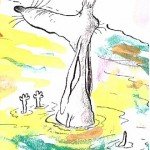 splashes of gorgeous watercolour. According to the book jacket, Catrow got into trouble with paints as a kid, lending these illustrations a certain authority. Poor mother. He is also a whiz with dogs.
splashes of gorgeous watercolour. According to the book jacket, Catrow got into trouble with paints as a kid, lending these illustrations a certain authority. Poor mother. He is also a whiz with dogs.
Children’s books written by celebrities are bad. Period. However….there is always an exception to the rule, and that exception is John Lithgow. It certainly helps that he is often partnered with one of my favourite illustrators-C.F. Payne, but overall, I’ve enjoyed the rhythm and humour of his books, especially The Remarkable Farkle McBride, and Micawber (Simon & Schuster, 2002), a book about an artist who just happens to be a squirrel. Micawber is first and foremost an art admirer. He makes weekly trips to the Metropolitan Museum of Art in New York to study the Miro’s and the Rembrandt’s. During one visit, he observes a young artist copying a Monet, and follows her home. At night in her small studio apartment, Micawber absconds with her art supplies, and using his tail, slaps paint on canvas for the first time~
 Micawber’s dull life, with its tedious toils
Micawber’s dull life, with its tedious toils
All at once seemed a hundred times duller
As he straddled a palette and squeezed out some oils
And discovered the wonders of colour!
Yup, that’s how it feels. Micawber visits her studio 30 more times, and by the end of the story has 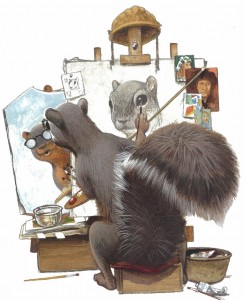 opened a gallery in the uppermost bubble of a carousel. In a breathtaking two-page spread, Micawber welcomes his neighbours, including a robin, various grasshoppers, and a pigeon to a showing of his paintings, each an homage to a great artist.
opened a gallery in the uppermost bubble of a carousel. In a breathtaking two-page spread, Micawber welcomes his neighbours, including a robin, various grasshoppers, and a pigeon to a showing of his paintings, each an homage to a great artist.
Of the many illustrators whose careers I have followed, few reach back farther than C.F. Payne. Along with many children’s picture books, his stunning illustrations have graced Time magazine covers, the New Yorker, and Reader’s  Digest, among others. Although his illustrations are steeped in realism, they are always given a humourous tweak, and this along with his penchant for Americana has positioned Payne to be the next Norman Rockwell. I love his stuff, and like Micawber at the Met, I have spent hours pouring over Payne’s work trying to decipher (steal) his technique. Rather unsuccessfully, I might add…
Digest, among others. Although his illustrations are steeped in realism, they are always given a humourous tweak, and this along with his penchant for Americana has positioned Payne to be the next Norman Rockwell. I love his stuff, and like Micawber at the Met, I have spent hours pouring over Payne’s work trying to decipher (steal) his technique. Rather unsuccessfully, I might add…
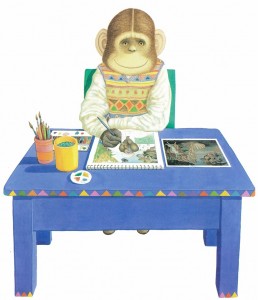 In one way or another, each of the previous books tip their collective berets to the artists of the past, but Willy’s Pictures (Candlewick Books, 2010) by former UK Children’s Laureate Anthony Browne is a direct, ape-centric love letter to the masterpieces, and the painters who created them. The overt pleasure of painting as a physical act is bypassed in favour of the inspiration a great piece of art can instill. Inspiration is the key here, as the paintings are not copies but representations of the original, with chimps and other primates insinuated into key roles.
In one way or another, each of the previous books tip their collective berets to the artists of the past, but Willy’s Pictures (Candlewick Books, 2010) by former UK Children’s Laureate Anthony Browne is a direct, ape-centric love letter to the masterpieces, and the painters who created them. The overt pleasure of painting as a physical act is bypassed in favour of the inspiration a great piece of art can instill. Inspiration is the key here, as the paintings are not copies but representations of the original, with chimps and other primates insinuated into key roles.
As both the narrator of the story and painter of the pictures, Willy the chimp, star of several books, is arguably a hirsute Anthony Browne in a sweater vest. In typical Brownean humour, Botticelli’s The Birth of Venus, now titled The Birthday Suit, a diaphanous Venus is replaced by 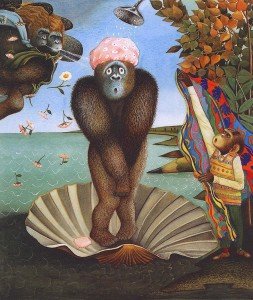 a gorilla on the half-shell, covering her ‘shame.’ The Creation of Adam by Michelangelo, as painted by Anthony Browne, has more in common with The Planet of the Apes than the bible. And so on. The illustrations in Willy’s Pictures, like all of his illustrations, are full of visual puns and hidden imagery. Once the eyes have lingered on, and deciphered these paintings, the actual works of art can be found at the back of the book. In some cases I would argue that Browne has improved upon the originals. Must be the bananas.
a gorilla on the half-shell, covering her ‘shame.’ The Creation of Adam by Michelangelo, as painted by Anthony Browne, has more in common with The Planet of the Apes than the bible. And so on. The illustrations in Willy’s Pictures, like all of his illustrations, are full of visual puns and hidden imagery. Once the eyes have lingered on, and deciphered these paintings, the actual works of art can be found at the back of the book. In some cases I would argue that Browne has improved upon the originals. Must be the bananas.
Often, the first introduction kids have to art is through picture books, and nothing lubricates a lesson better than passion and especially, humour. The books in this post are 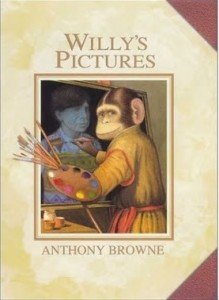 full of joy: the joy of painting, the joy of learning, and quite simply, the absolute joy of a beautiful picture book. I extend my gratitude to these writers and illustrators for reminding us that art is important, that we must value artists, past and present, and that there is nothing, nothing more joyful than splashing paint on a canvas. Or a wall. Or a tree…
full of joy: the joy of painting, the joy of learning, and quite simply, the absolute joy of a beautiful picture book. I extend my gratitude to these writers and illustrators for reminding us that art is important, that we must value artists, past and present, and that there is nothing, nothing more joyful than splashing paint on a canvas. Or a wall. Or a tree…
PREVIOUSLY REVIEWED BOOKS ABOUT ART:
Grant and Tillie Go Walking (click on link for full review – about Grant Wood) by Monica Kulling and Sydney Smith
Any Questions? (click on link for full review) by Marie-Louise Gay
Young Frank Architect (click on link for full review) by Frank Viva
Coppernickel Goes Mondrian (click on link for full review) by Wouter Van Reek
On Tumbledown Hill (click on link for full review) by Tim Wynne-Jones and Dušan Petričić
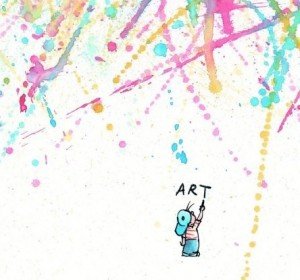 Additional Suggestions (not yet reviewed):
Additional Suggestions (not yet reviewed):
Art by Patrick McDonnell
Seen Art? by Jon Scieszka and Lane Smith
The Blue Rider: The Yellow Cow Sees the World in Blue by Eric Carle
Linnea in Monet’s Garden by Cristina Bjork and Lena Anderson


Donna, What a cooincidence! Friday I participated in a workshop about childrens books and part of the focus was on books on art and artists. “Willy’s Pictures” was one of the books we discussed. Another you may be interested in is
“Rojo, azul y un poco de amarillo / Red, Blue and a little bit of Yellow” by Björn Sortland. Another was by Mario Giordano called “Bilderräuber: die größten Kunstdiebstahle” (“Art thieves: the biggest art Thefts”, is my goofy translation), though unfortunately it doesn’t seem to have been translated into English yet. Thanks for a magnificent post!
Thanks Lisa, that is strange! Both books look intriguing…especially Rojo, azul y un poco de amarillo. I am hoping to build this list, so thanks for the suggestions.
Donna